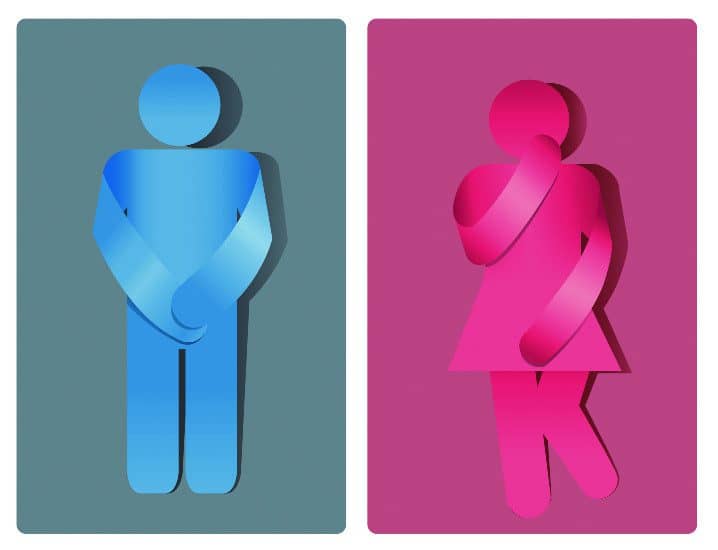By Francesco Amico, PhD
Urinary and fecal incontinence are very common disabling syndromes that can severely impact quality of life and well-being. Population-based studies have shown that urinary incontinence (the unintentional leakage of urine) ranges between 2% and 25% in adults and that it is three times more common in women than in men. On the other hand, the prevalence of fecal incontinence (the unintentional loss of solid or liquid stool) ranges between 2% and 20% in the adult population, and it equally affects men and women.
While symptoms may vary depending on the diagnosis, patients with incontinence generally have little or no control of urine or fecal passing. This can severely impact their lifestyle, forcing them to withdraw from day-to-day physical activity, which often leads to a reduction in mobility and increases the risk for highly debilitating diseases such as cardiovascular diseases, diabetes, obesity, colon and breast cancer, osteoporosis, depression, and anxiety.
Incontinence is typically associated with the reduced control of the pelvic floor muscles (PFM) and bladder and/or rectal sphincters, which can be linked to a number of risk factors including:
- Older age
- Obesity
- Gynecological surgery
- Pregnancy and vaginal childbirth
- Prolonged work or exercise
- Constipation
- Prostate surgery
- Chronic coughing
- Other conditions that may cause an increase in abdominal pressure
A growing number of clinical studies support the use of bladder training and training of the PFM as effective strategies to reduce incontinence episodes and its impact on well-being. One of the most successful training methods is “biological feedback” or biofeedback training, a non-invasive treatment that allows the patient to learn how to selectively and actively regain control of the leakage.
Over the last decade, biofeedback training has become an increasingly popular method to treat incontinence with an increasing number of doctors recommending it to their patients. Importantly, clinical evidence shows that treatment improvement for patients undergoing biofeedback training for urinary incontinence can be more than 70% and that, in less than 60% of cases, biofeedback training is more beneficial than alternative treatment methods.
Briefly, this is how biofeedback training for urinary or fecal incontinence works:
- An electronic “educator” device is wired to a probe connected to the PFM
- The probe continuously monitors PFM tension and quality of contractions
- Feedback of PFM muscle tension and contraction is given to the patient in the form of visual or auditory signals
- During the training sessions, the patient is guided by a bar graph or a tone to contract/relax the PFM throughout a series of exercises, including tense/relax and quick flicks. As with any muscle being trained, this increases the size of the PFM, strengthens its tone at rest, and heightens awareness of its contraction. Additionally, studies show that greater awareness of PFM contraction provides greater control over incontinence episodes due to laughing, coughing, or sneezing.
Recent technological advances now provide biofeedback training protocols, so that biofeedback training sessions can run with or without the assistance of dedicated biofeedback specialists.
Thought Technology has developed powerful state-of-the-art technology equipped with surface electromyography (sEMG) sensors that measure and display muscle activity in real time, with a selection of ready-to-run muscle rehabilitation protocols designed to target the most common symptoms of incontinence. Their technology offers both clinicians and patients seeking non-invasive solutions to incontinence the opportunity to improve control in stand-alone interventions or in combination with other personalized treatments. To learn more about the company’s surface PFM biofeedback training system, visit https://thoughttechnology.com/applications/#continence-training. PTP
Francesco Amico, PhD, is a behavioral neuroscientist with over 20 years’ experience in neuropsychological research. His original work focuses on the development of novel technology to improve the diagnosis and treatments of neurological/neuropsychiatric disorders. He also regularly collaborates with clinics throughout North America providing consultancy on neurofeedback training. For more information, contact [email protected].
References
- Abrams P, Cardozo L, Fall M, et al. The standardisation of terminology in lower urinary tract function: report from the standardisation sub-committee of the International Continence Society. Urology. 2003;61(1):37-49.
- Andersson KE, Appell R, Cardozo LD, et al. The pharmacological treatment of urinary incontinence. BJU Int. 1999;84(9):923-47.
- Ashton-Miller JA, Howard D, DeLancey JO. The functional anatomy of the female pelvic floor and stress continence control system. Scand J Urol Nephrol Suppl. 2001;(207):1-7; discussion 106-25.
- Balk EM, Adam GP, Corsi K, Mogul A, Trikalinos TA, Jeppson PC. Adverse events associated with nonsurgical treatments for urinary incontinence in women: a systematic review. J Gen Intern Med. 2019;34(8):1615-1625.
- Bo K, Talseth T, Holme I. Single blind, randomised controlled trial of pelvic floor exercises, electrical stimulation, vaginal cones, and no treatment in management of genuine stress incontinence in women. BMJ. 1999;318(7182):487-93.
- Bouchard C, Shephard RJ, Stephens T. Physical Activity, Fitness and Health: The Model and Key Concepts in Physical Activity, Fitness and Health: International Proceeding and Consensus Statement. Human Kinetics, Ed. Champaign, Illinois; 1994.
- Bump RC, Norton, PA. Epidemiology and natural history of pelvic floor dysfunction. Obstet Gynecol Clin North Am. 1998;25(4): 723-46.
- Burgio KL, Goode PS, Urban DA, et al. Preoperative biofeedback assisted behavioral training to decrease post-prostatectomy incontinence: a randomized, controlled trial. J Urol. 2006;175(1):196-201; discussion 201.
- Demaagd GA, Davenport, TC. Management of urinary incontinence. P T. 2012;37(6):345-361H.
- Hay-Smith EJ, Berghmans LC Bo, Hendriks HJ, de Bie RA, van Waalwijk van Doorn ES, Pelvic floor muscle training for urinary incontinence in women. Cochrane Database Syst Rev. 2001;(1):CD001407.
- Hunskaar S, Arnold EP, Burgio K, Diokno AC, Herzohg AR, Mallett VT. Epidemiology and natural history of urinary incontinence. Int Urogynecol J Pelvic Floor Dysfunct. 2000;11(5):301-19.
- Kopanska M, Torices S, Czech J, Koziaara W, Toborek M, Dobrek L. Urinary incontinence in women: biofeedback as an innovative treatment method. Ther Adv Urol. 2020;12:1756287220934359.
- Lose G. Simultaneous recording of pressure and cross-sectional area in the female urethra: a study of urethral closure function in healthy and stress incontinence women. Neurourol Urodyn. 1992;11(2):54-89.
- Milsom I, Gyhagen M. The prevalence of urinary incontinence. Climacteric. 2019;22(3):217-222.
- Ng KS, Sivakumaran Y, Nassar N, Gladman MA. Fecal incontinence: community prevalence and associated factors–a systematic review. Dis Colon Rectum. 2015;58(12):1194-209.
- Nightingale G. Management of urinary incontinence. Post Reprod Health. 2020;26(2):63-70.
- Nikolopoulos KI, Betschart C, Doumouchtsis SK. The surgical management of recurrent stress urinary incontinence: a systematic review. Acta Obstet Gynecol Scand. 2015;94(6):568-76.
- Prota C, Gomes CM, Ribeiro LHS, et al. Early postoperative pelvic-floor biofeedback improves erectile function in men undergoing radical prostatectomy: a prospective, randomized, controlled trial. Int J Impot Res. 2012;24(5):174-8.
- Schreiner L, Guimaraes dos Santos T, Borba Anton de Souza A, Campani Nygaard C, Gomes da Silva Filho I. Electrical stimulation for urinary incontinence in women: a systematic review. Int Braz J Urol. 2013;39(4): 454-64.
- Smith AL, Wein AJ. Urinary incontinence: pharmacotherapy options. Ann Med. 2011;43(6):461-76.
- US Department of Health and Human Services and N.C.f.C.D.P.a.H. Promotion, Physical activity and health: a report of the Surgeon General. Atlanta; 1996.
- Wilson PD, K.-S.J. Bø, Nygaard I. Conservative treatment in women. In: Incontinence. Abrams P, Cardozo L, Khoury S, Eds. 2002; Plymbridge Ltd, Health Publication: Plymouth. 571-624.





